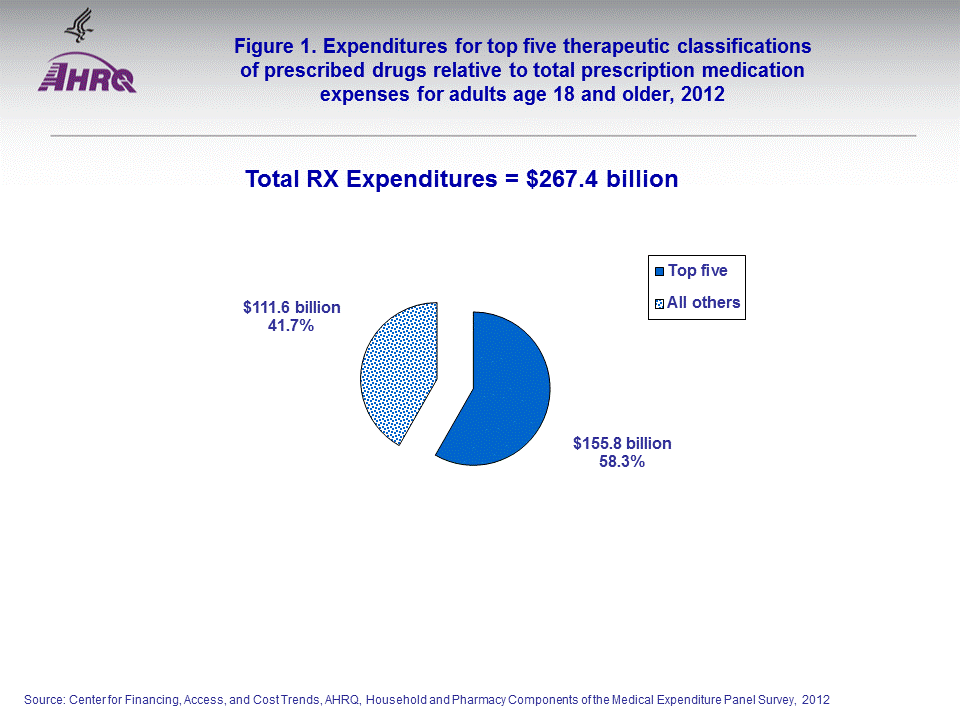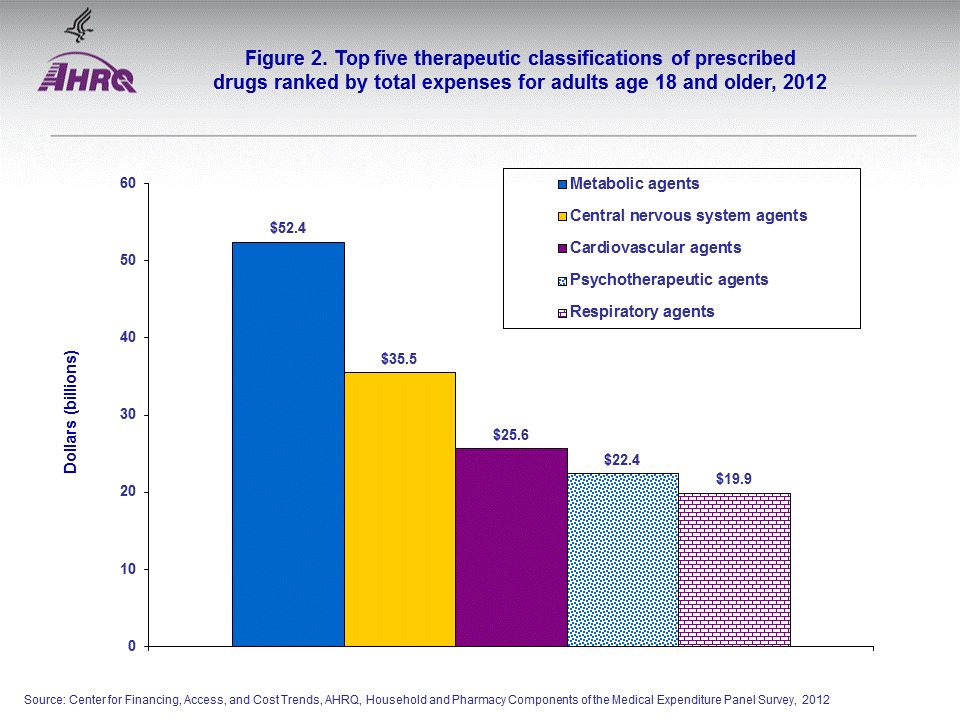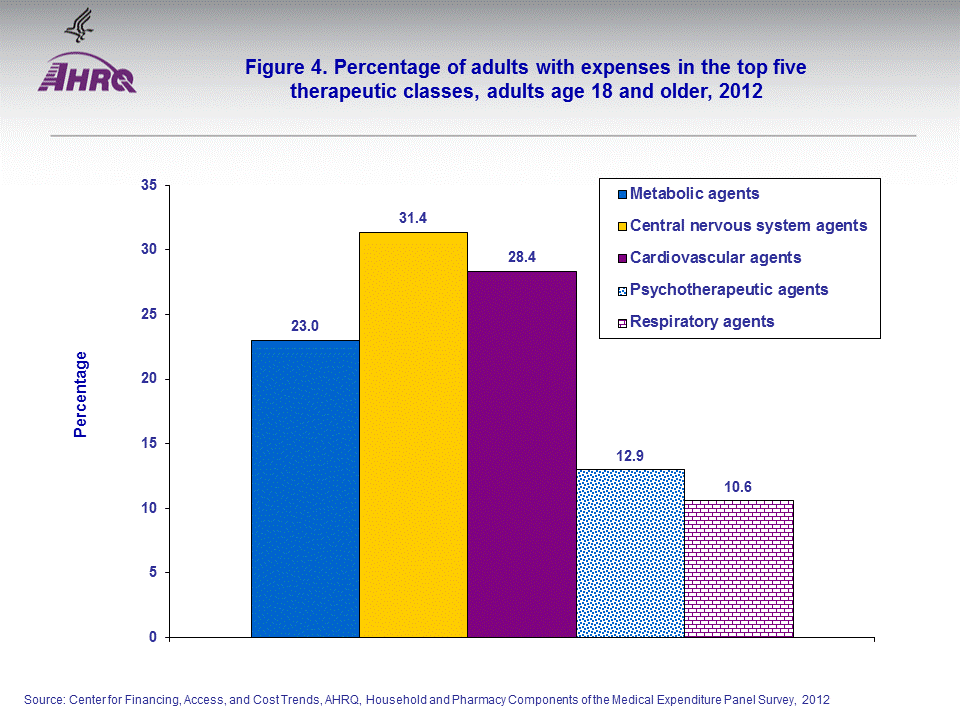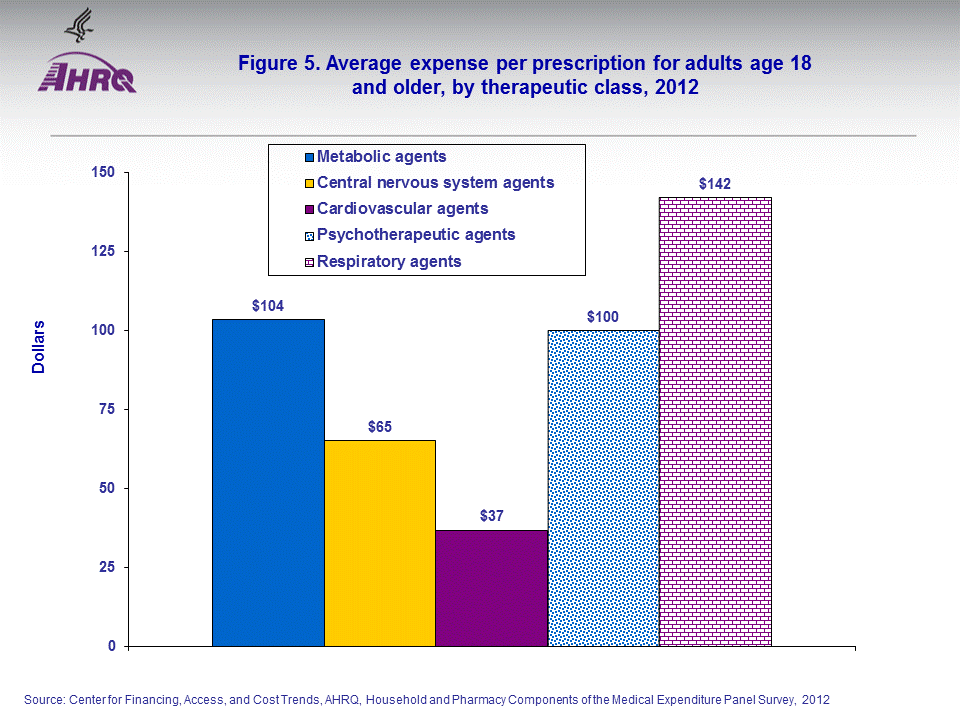
|
|
Font Size:
|
||||
|
|
|
|
||||
STATISTICAL BRIEF #468:
Expenditures for the Top Five Therapeutic Classes of Outpatient Prescription Drugs, Adults Age 18 and Older, U.S. Civilian Noninstitutionalized Population, 2012
Highlights
- In 2012, the top five therapeutic classes of prescription drugs ranked by total expense among adults were metabolic agents, central nervous system agents, cardiovascular agents, psychotherapeutic agents, and respiratory agents.
- Expenditures for the top five therapeutic classes totaled $155.8 billion and accounted for about 58 percent of total expenditures on prescription drugs purchased for the adult population in 2012.
- Expenses for metabolic agents accounted for a little less than one-fifth of total prescription drug expenses for adults in 2012.
- More than three in ten adults purchased a central nervous system agent in 2012.
- In 2012, among the top five therapeutic classes of drugs, the highest average expense per prescription was for respiratory agents.
Introduction
This Statistical Brief provides descriptive statistics on expenditures for the top five most costly therapeutic classes of outpatient prescription drugs, ranked by total expenses in 2012 for adults age 18 and older in the U.S. civilian noninstitutionalized population. Prescription drug therapeutic classes are defined according to the Multum/Lexicon therapeutic classification system (see "Definitions"). In 2012, 17 broad therapeutic classifications were identified.The estimates presented are derived from the Household and Pharmacy Components of the 2012 Medical Expenditure Panel Survey (MEPS). Expenditures include payments from all sources (e.g., out of pocket, private, and public insurance sources) for outpatient prescription drug purchases during 2012. Insulin and diabetic supplies and equipment are also included in MEPS prescribed medicines estimates. Over-the-counter medicines are excluded from these estimates as are prescription medicines administered in an inpatient setting or in a clinic or physician's office. All differences discussed in the text are statistically significant at the 0.05 level or better.
Findings
In 2012, the top five therapeutic classes of prescribed drugs purchased by adults age 18 and older (ranked by total expense) accounted for 58.3 percent ($155.8 billion) of the $267.4 billion total prescription drug expenses by adults (figure 1).Metabolic agents had the highest total expenses ($52.4 billion) among all therapeutic classes for adults age 18 and over (figure 2). The second through fifth highest therapeutic classes, respectively, in terms of total expenditures, were central nervous system agents ($35.5 billion), cardiovascular agents ($25.6 billion), psychotherapeutic agents ($22.4 billion), and respiratory agents ($19.9 billion). When expressed as percentages of all prescribed medicine expenses for adults, these classes ranged from 19.6 percent for metabolic agents to 7.4 percent for respiratory agents (figure 3).
Among the U.S. adult population, 31.4 percent purchased central nervous system agents (figure 4). Cardiovascular agents were purchased by 28.4 percent of the population and a little less than one-fourth (23.0 percent) of the population purchased metabolic agents. A smaller portion of the population purchased psychotherapeutic agents (12.9 percent) or respiratory agents (10.6 percent).
Data Source
The estimates shown in this Statistical Brief are based on data from the MEPS 2012 Full Year Consolidated Data File and MEPS-HC 2012 Prescribed Medicines File.Definitions
Therapeutic classificationsTherapeutic class and subclass were assigned to MEPS prescribed medicines using Multum Lexicon variables from Cerner Multum, Inc. MEPS prescribed medicines files were linked to the Multum Lexicon database to obtain therapeutic class and subclass variables.
Therapeutic class cardiovascular agents include calcium channel blockers and diuretics; central nervous system agents include the analgesics, anticonvulsants, and antiparkinson agents. The therapeutic class of gastrointestinal agents includes the H2-receptor antagonists, antacids, antidiarrheals, and proton pump inhibitors; metabolic agents include the subclasses of antihyperlipidemic agents and antidiabetic agents; and psychotherapeutic agents include the subclass of antidepressants and antipsychotics.
Cerner Multum occasionally makes changes to the Multum Lexicon therapeutic classification system. For example, antihyperlipidemic agents was its own therapeutic class in the 2003 and 2004 data, but was reclassified as a therapeutic subclass of the new therapeutic class, metabolic agents, in 2005.
About MEPS-HC
MEPS-HC is a nationally representative longitudinal survey that collects detailed information on health care utilization and expenditures, health insurance, and health status, as well as a wide variety of social, demographic, and economic characteristics for the U.S. civilian noninstitutionalized population. It is cosponsored by the Agency for Healthcare Research and Quality and the National Center for Health Statistics.For more information about MEPS, call the MEPS information coordinator at AHRQ (301-427-1656) or visit the MEPS Web site at http://www.meps.ahrq.gov/.
References
For a detailed description of the MEPS-HC survey design, sample design, and methods used to minimize sources of nonsampling error, see the following publications:Cohen, J. Design and Methods of the Medical Expenditure Panel Survey Household Component. MEPS Methodology Report No. 1. AHCPR Pub. No. 97-0026. Rockville, MD. Agency for Health Care Policy and Research, 1997. http://www.meps.ahrq.gov/mepsweb/data_files/publications/mr1/mr1.shtml
Cohen, S. Sample Design of the 1996 Medical Expenditure Panel Survey Household Component. MEPS Methodology Report No. 2. AHCPR Pub. No. 97-0027. Rockville, MD. Agency for Health Care Policy and Research, 1997. http://www.meps.ahrq.gov/mepsweb/data_files/publications/mr2/mr2.shtml
Cohen, S. Design Strategies and Innovations in the Medical Expenditure Panel Survey. Medical Care, July 2003: 41(7) Supplement: III-5–III-12.
Ezzati-Rice, T.M., Rohde, F., Greenblatt, J. Sample Design of the Medical Expenditure Panel Survey Household Component, 1998–2007. Methodology Report No. 22. March 2008. Agency for Healthcare Research and Quality, Rockville, MD. http://www.meps.ahrq.gov/mepsweb/data_files/publications/mr22/mr22.shtml
Suggested Citation
Roemer, M. Expenditures for the Top Five Therapeutic Classes of Outpatient Prescription Drugs, Adults Age 18 and Older, U.S. Civilian Noninstitutionalized Population, 2012. Statistical Brief #468. February 2015. Agency for Healthcare Research and Quality, Rockville, MD. http://www.meps.ahrq.gov/mepsweb/data_files/publications/st468/stat468.shtmlAHRQ welcomes questions and comments from readers of this publication who are interested in obtaining more information about access, cost, use, financing, and quality of health care in the United States. We also invite you to tell us how you are using this Statistical Brief and other MEPS data and tools and to share suggestions on how MEPS products might be enhanced to further meet your needs. Please email us at MEPSProjectDirector@ahrq.hhs.gov or send a letter to the address below:
Steven B. Cohen, PhD, Director
Center for Financing, Access, and Cost Trends
Agency for Healthcare Research and Quality
540 Gaither Road
Rockville, MD 20850
 |
||||||||||||||
|
||||||||||||||
|
|
||||||||||||||
 |
||||||||||||||
|
||||||||||||||
|
|
||||||||||||||
 |
||||||||||||||
|
||||||||||||||
|
|
||||||||||||||
 |
||||||||||||||
|
||||||||||||||
|
|
||||||||||||||
 |
||||||||||||||
|
||||||||||||||
|
|
||||||||||||||


